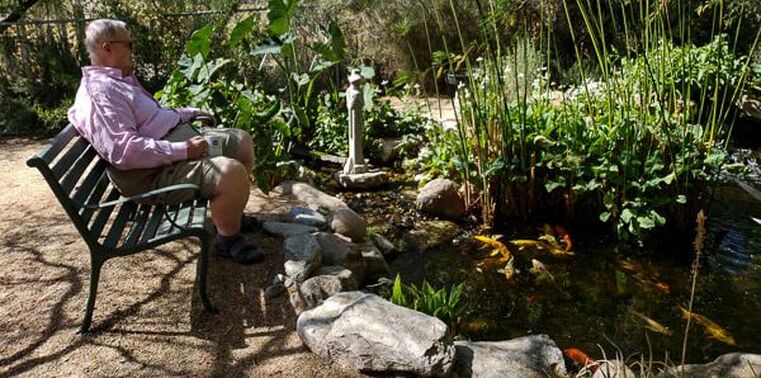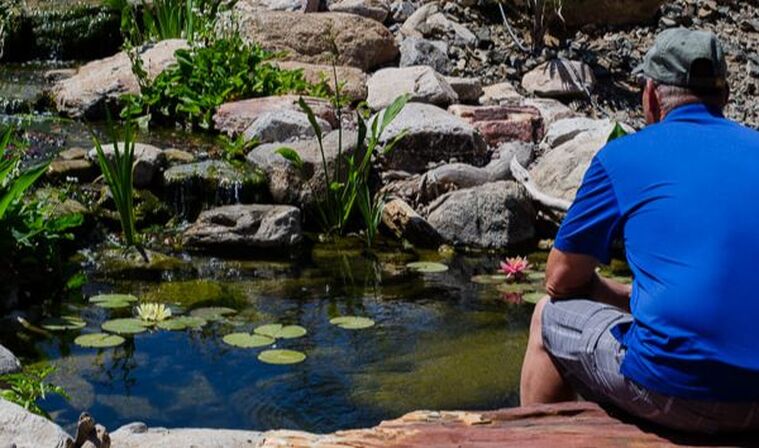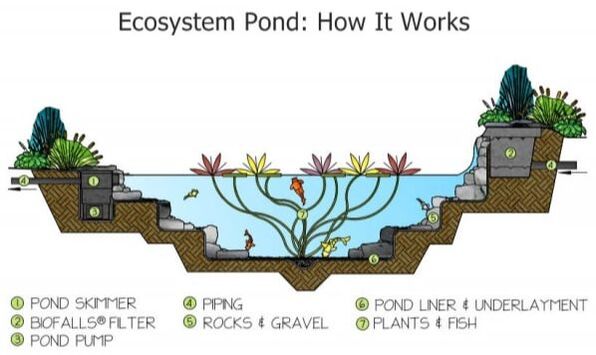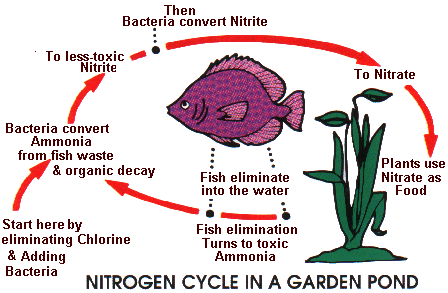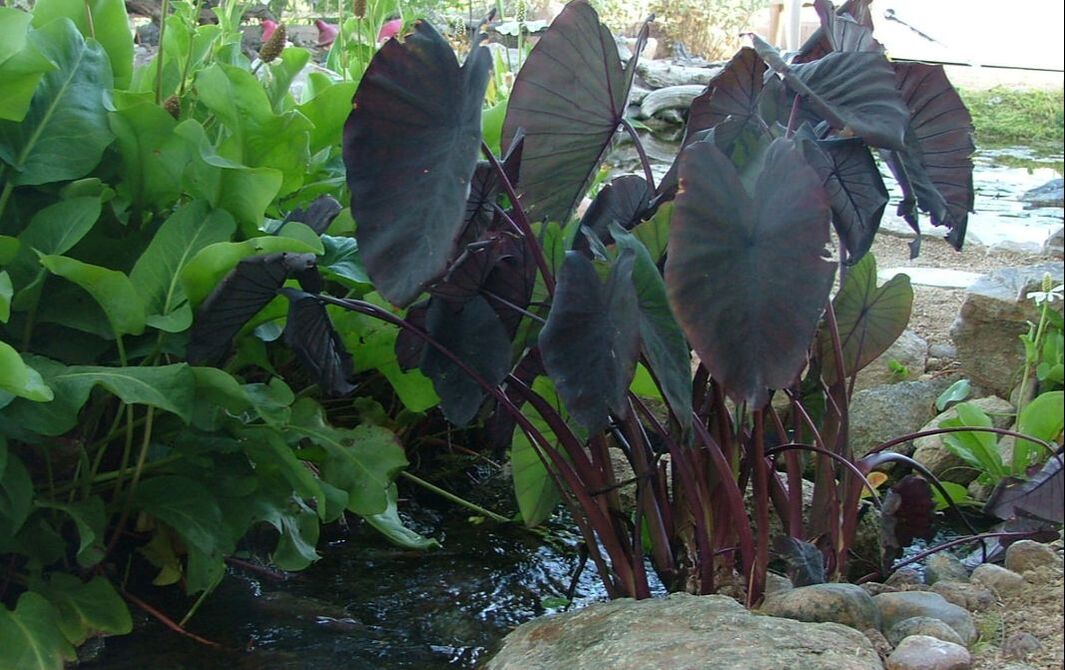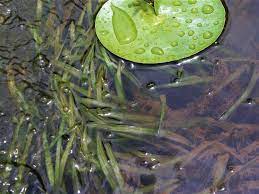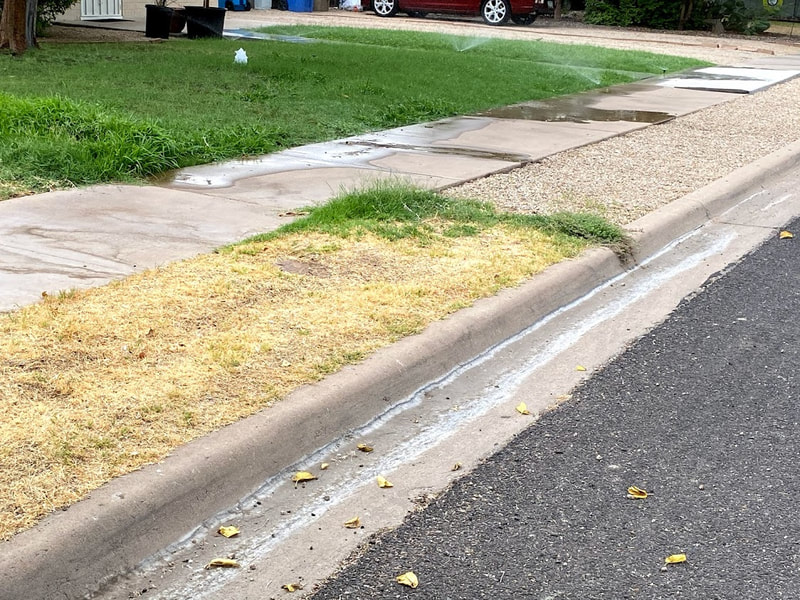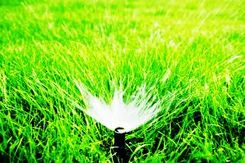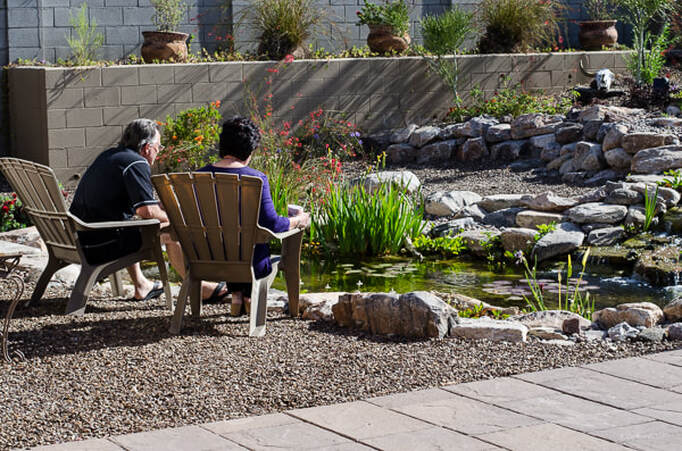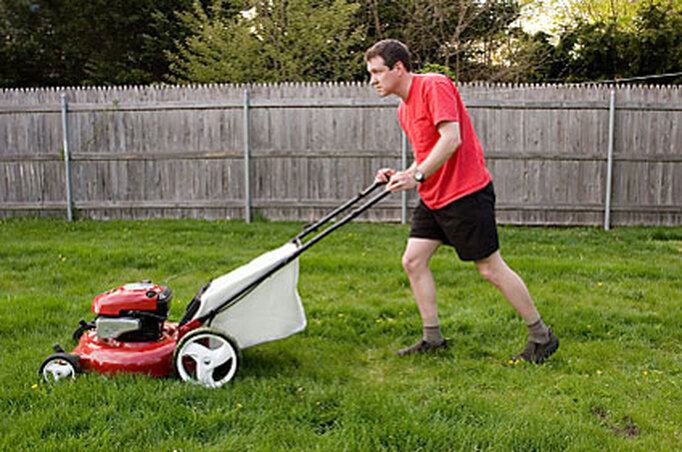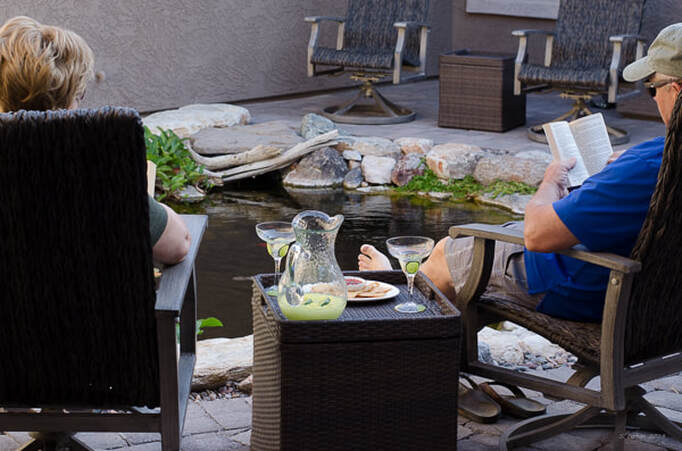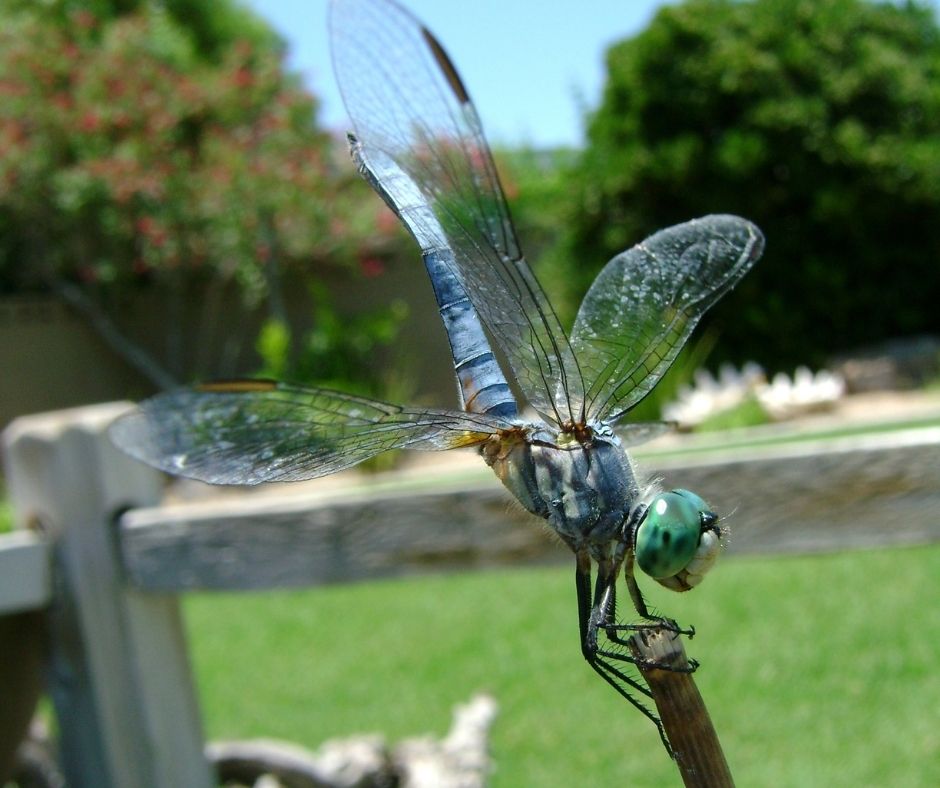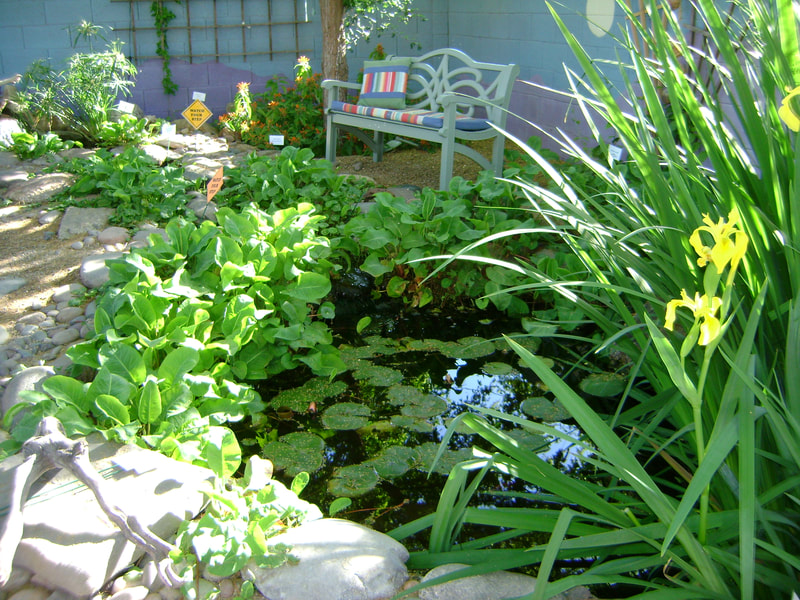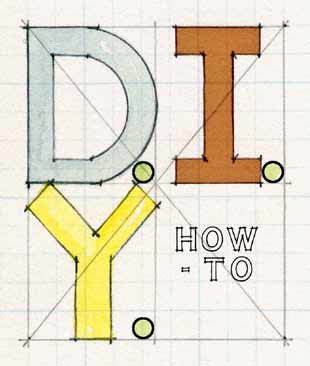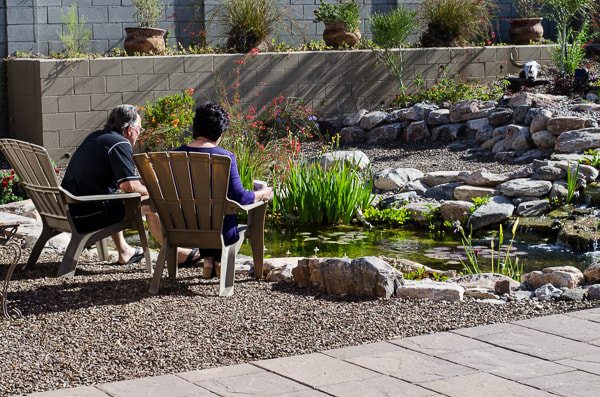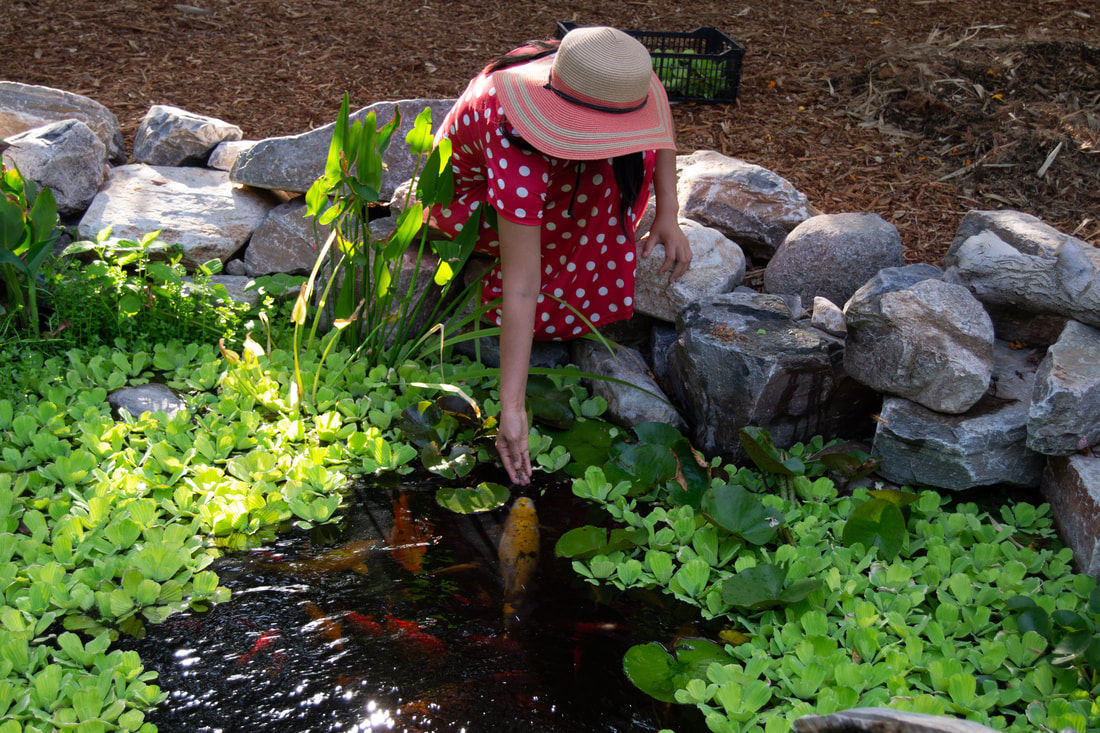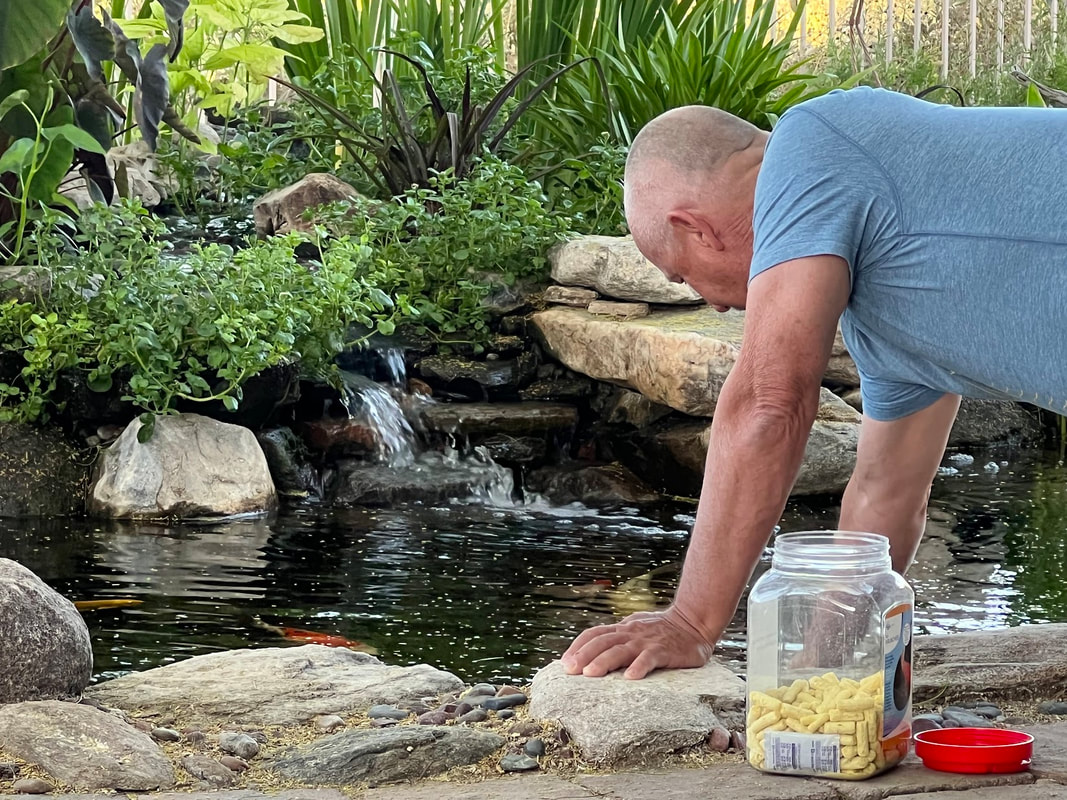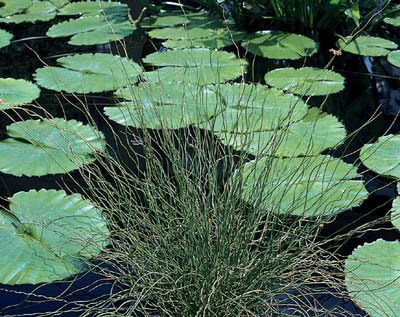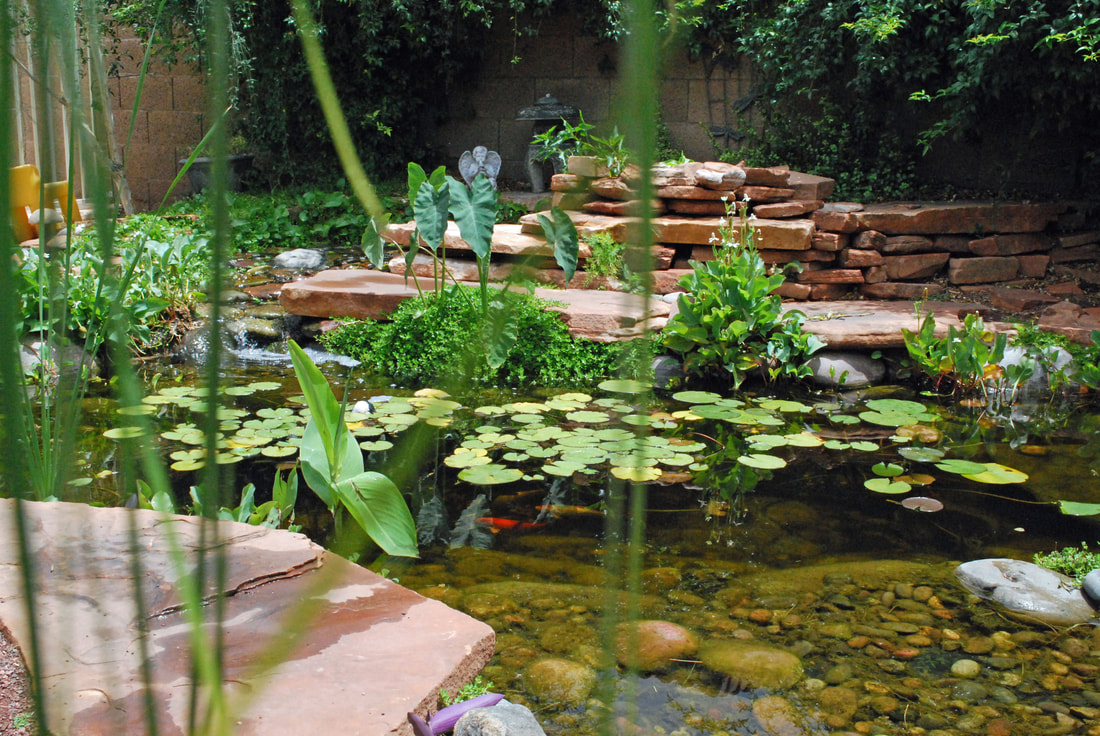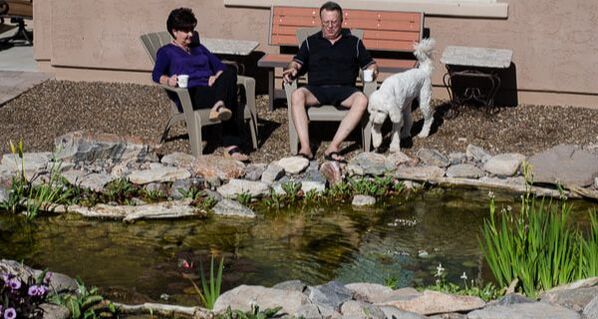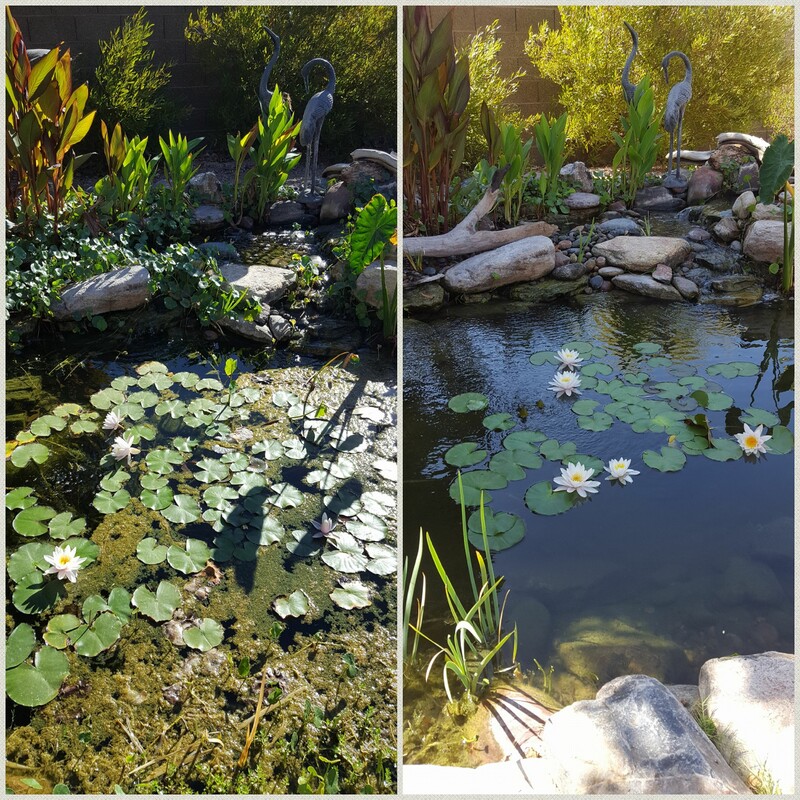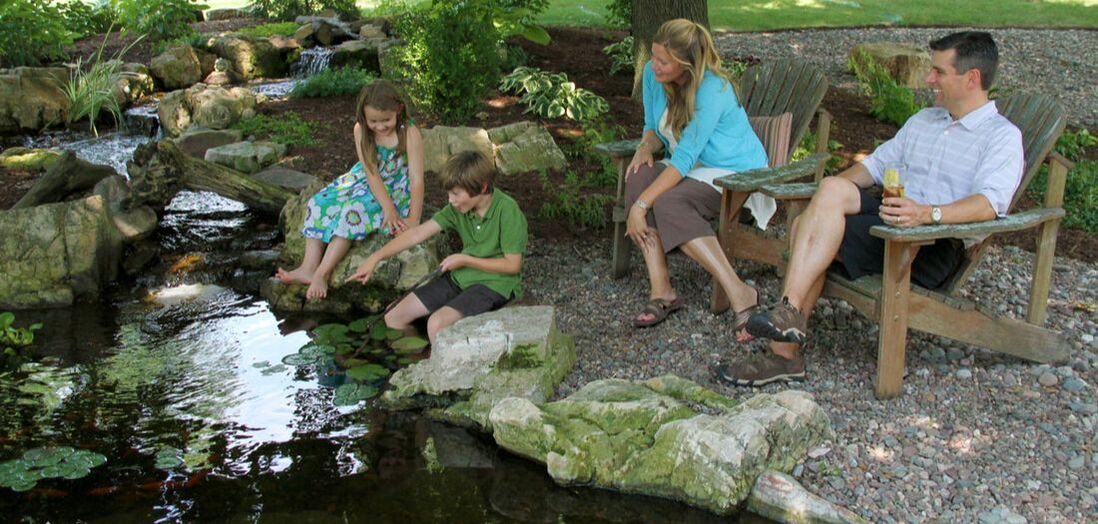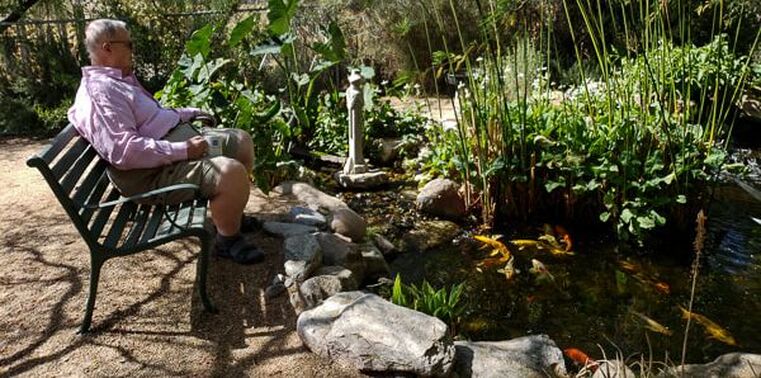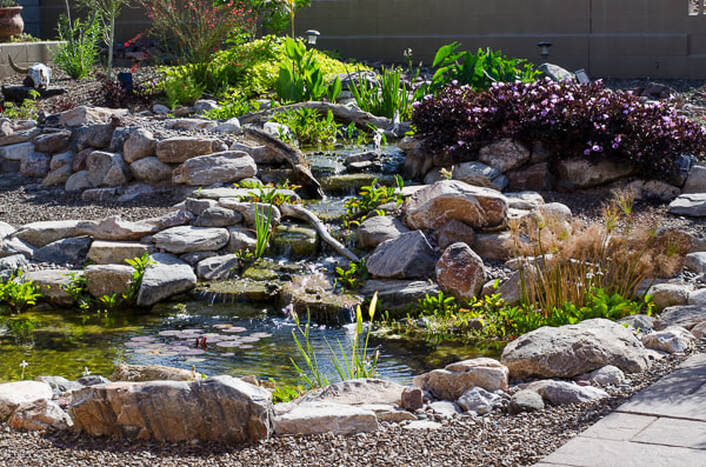|
Fish dart beneath lily pads while the melodious sound of a waterfall entertains your ears. Lush aquatic and terrestrial plants make you just want to take deep breaths of oxygen-rich fresh air. Enjoying a naturally balanced pond in your backyard is an attainable luxury for every homeowner. Most pond owners are aware of the importance that good water quality plays in a complete pond ecosystem. However not knowing how to get or keep water quality can prove challenging to some pond owners. A bit of basic knowledge will help you keep your pond looking beautiful and performing optimally. In addition to plants, fish, aeration, and rocks & gravel, a low-maintenance ecosystem pond requires adequate filtration to keep the water clean and clear. Three types of pond filters are available on the market and include biological, mechanical, and clarifiers.
The Job of a Pond SkimmerThe main function of mechanical filtration, or pond skimmer, is to remove debris before it sinks to the bottom of the pond and decays. The skimmer also houses and hides from view the pump and plumbing, as opposed to being placed directly in the pond where they can be an eyesore. There are two main types of skimmers: box skimmers and floating skimmers. Both types filter the water by removing floating debris and waste before it’s had a chance to fall to the bottom of the pond. The box skimmer is the predominant type of skimmer on the market today because it’s easy to maintain. Box-style skimmers come with either vertical or horizontal filter mats. Horizontal mats prove to be the most effective while providing the least amount of maintenance. In addition to frequent cleaning, vertical mats need to be constantly monitored to make sure there is enough water in the pump chamber for the pump to operate properly. An advantage of horizontal filter mats is that they lay flat so there is no sagging and they don’t lose their shape. They also never clog to the point of preventing water from passing through, so the pump chamber won’t run dry. As water enters the skimmer, the large debris are caught in the skimmer basket and the water is then further filtered through the horizontal mat. The pond water then travels up to the biological filter via the underground plumbing where it’s further treated before re-entering the pond. Biological Pond Filtration Goes to WorkThe biological filter receives water that has already passed through the mechanical filter, or skimmer, typically placed on the opposite side of the pond. The water enters the biological filter via flexible pipe located near the base of the unit. The water then flows from the bottom to the top of the filter, traveling through filter media housed inside the unit. This filter media helps with the removal of fine to medium-sized particles after the larger debris has already been removed by the skimmer. As the biological filter fills, it will overflow and pour over its waterfall lip, cascading down rocks that have been set to create a beautiful, natural-looking waterfall. The waterfall creates aeration for the pond, assisting in the circulation and health of the water Biological filters on the market today range in size and can filter ponds up to 10,000 gallons. For larger ponds, multiple biological filters can be incorporated into the design. The Science Behind the DesignMechanical and biological filtration are critical to processing the many types of nutrients found in a pond ecosystem, including fish waste, uneaten fish food, leaves, and runoff from lawns, to name just a few. High levels of ammonia (a form of nitrogen) are highly toxic to fish and are a major contributor to prolific algae growth, so they need to be carefully controlled. In water gardening, the primary nutrient that biological filtration utilizes and renders usable is nitrogen. In biological filtration, nitrifying bacteria, known as facultative bacteria, absorb ammonia and turn nitrites into less dangerous nitrates. These bacteria require oxygen to live, so it’s important for the pond’s pump to run 24/7/365. If the pump isn’t running, the waterfalls aren’t flowing, and aeration is eliminated from the necessary equation to maintain an ecosystem pond. Keep in mind that if the pump shuts down, the bacteria will quickly use up all of the oxygen and die, which isn’t a good thing. Nitrates are then removed from the pond by another biological filtration method known as de-nitrification. This process occurs only in anaerobic (without oxygen) areas of the pond. That’s why it’s not necessarily bad for some areas of the pond to experience minimal water flow (such as on the bottom of the pond, under an inch or so of gravel). The bacteria that live in this area of the pond turn nitrates into nitrogen gas, which is released into the atmosphere. Nitrates are also absorbed by aquatic plants and algae during their growth processes. A pond without aquatic plants will prove to be a maintenance nightmare. For any biological filtration to work, there needs to be billions of bacteria working to purify the water. They prefer to anchor onto things, which is why surface area is so important. More surface area means more bacteria and more bacteria means better biological filtration. The surface area is provided by filter media, rocks, and gravel. A pond with gravel on the bottom will contain more surface area for bacteria, as opposed to a pond with exposed liner on the bottom. The Role of Aquatic PlantsAnother important component of pond filtration is the use of plants. Many gardeners add a pond to their landscape for the variety of aquatic plants available, and while their beauty is certainly an aesthetic asset, a critical benefit is the work these plants do to help filter the water. Plants help purify pond water by reducing nutrients, filtering out sediments, and absorbing toxic compounds through the process of phytoremediation. If these excess nutrients are not removed, algae will feed on them, resulting in green water, string algae, or both. Algae control is not the only way plants help create a low-maintenance ecosystem pond. Submerged and marginal plants also provide food, shade, and protection for the fish and other wildlife that live in and around the pond. Low-Maintenance Pond ExperienceTo keep pond water quality high, the simple process of repeatedly turning the water over through mechanical and biological filters is needed to create a naturally balanced, low-maintenance ecosystem pond. Add the remaining components of plants, fish, aeration, rock, and gravel, and you’ll find greater success in maintaining clean and clear pond water. Your fish are happier and less stressed when their environment is healthy. Not to mention, it’s so much more enjoyable when you can actually see your fish swimming in clean water created by an efficient pond filtration system. OTHER POSTS YOU MIGHT ENJOY: Backyard ponds have become an exciting landscaping trend! Most homeowners want a pond to add ambiance to their yard or to simply enhance their outdoor living space. Their goals range from fish collecting to plant collecting to simply wanting to enjoy the sight and sound of water. Ponds create a respite from the techno-crazy world and a haven for prized Koi and local wildlife. Yet few realize the countless environmental benefits of installing an ecosystem pond or water feature. According to the National Gardening Association’s 2008 Environmental Lawn and Garden Survey, 9 out of 10 households believe it’s important to maintain their landscape in a way that benefits the environment. However, only about half of those are knowledgeable about how to maintain lawns and gardens in an environmentally-friendly way. Lots of homeowners hire a service to care for their landscape, and as long as it looks good, they don't really pay attention to what chemicals are being used, etc. Those that maintain their own, tend to run to the big-box store, buy chemicals, don't really read the instructions, and use way more than what is truly necessary. Many people don’t realize that by replacing some (or all) of their lawn with a pond or water feature, they can conserve water and energy, save money, and support the environment – not to mention reduce personal stress. Lawns use A LOT of waterAccording to the University of Arizona, the average 15'x15' bermudagrass lawn uses over 5,000 gallons of water per year. A typical residential lawn sprinkler system broadcasts about 10–18 gallons per minute, per valve or zone. By the way, broadcasting water like that increases evaporation and the lawn doesn’t really receive as much water as is being broadcast. So, if a lawn has two zones and runs for 15 minutes each three times per week, the water consumption would range between 4,500 and 7,560 gallons per month. In Phoenix, that would equate to about $175 to $275 per month on your water bill. Yikes! PONDS USE LESS WATER THAN A LAWNEvaporation on a pond is the same as on a swimming pool: 1” per day per square footage of surface area during the hottest, driest months of the year (typically mid-May through mid-June). During the rest of the year, the evaporation is negligible. AND you’re not adding water during monsoon storms and general rain days. Unless you have one of those expensive timers that detects the moisture in the air and doesn’t water when it’s raining, your lawn gets watered no matter what. A pond will have an autofill device that only adds water when it’s needed. Lawns GENERALLY require more maintenance than pondsMaintaining a lush lawn obviously requires regular watering, as pointed out above. But there’s also a LOT more that goes into maintaining a nice-looking lawn, right? You also have to fertilize it. When not done properly, runoff of excess fertilizer causes groundwater pollution. The EPA estimates that only 35 percent of lawn fertilizers applied ever reach the grass plant – the remainder ends up in our air or seeps into our water supply. During a typical year in neighborhoods across the country, over 102 million pounds of toxic pesticides are reportedly applied in pursuit of that perfect lawn and garden, says the National Coalition for Pesticide-Free Lawns. Is your “little patch of estate” worth that? You have to mow and edge it, enslaving the average man (or woman) for at least half a day on any given weekend. Aside from the time involved, about 54 million Americans mow their lawns each weekend, using 800 million gallons of gas per year, AND producing tons of air pollutants, according to the US Environmental Protection Agency (EPA). Garden equipment engines emit high levels of carbon monoxide, volatile organic compounds, and nitrogen oxides, producing up to 5% of the nation’s air pollution (and a good deal more in metropolitan areas). A traditional gas-powered lawn mower produces as much air pollution as 43 new cars, each being driven 12,000 miles. Lastly, more than 17 million gallons of gas are spilled each year refueling lawn and garden equipment. To put that into perspective, that’s more than the amount of oil that was spilled by the Exxon Valdez in the Gulf of Alaska. And this all adds to groundwater contamination and smog, the EPA reports. And then there's the noise pollution. The sounds of lawn mowers and edgers are NOT soothing. They are an irritant to anyone within range. PONDS ADD TO THE AMBIENCE AND REDUCE STRESSPonds, however, reduce the need for lawn pesticides and fertilizers. They require about 10 minutes of maintenance per week, and pay you back with hours of enjoyment. And they certainly don’t require any gas-powered equipment. As an added benefit, the debris and sludge collected by your pond filter can be used as a nutrient-rich fertilizer for your lawn, garden, and/or trees. And as to sound, who wouldn't rather listen to a waterfall or babbling brook rather than mowers & blowers? Now, if you have a bunch of kids that need a football or soccer field to play on, then by all means, plant a lawn! Or you could make use of a nearby park and let the City deal with the time and cost of the maintenance. But if you’re looking for a low water use, low maintenance, super enjoyable, and entertaining landscape option, you might want to consider an ecosystem pond or water feature. OTHER POSTS YOU MIGHT ENJOY: Unveiling the Enchantment: The Perfect Harmony of Design and Ecosystem for a Beautiful Pond7/15/2023
There's something truly captivating about a beautiful pond that draws us into its tranquil embrace. Whether nestled in a garden or gracing a grand estate, these shimmering water bodies have an inherent allure that seems to enchant us effortlessly. But have you ever wondered what creates this magical ambiance? Delving into the world of ponds, we discover that the secret lies in the art of design and the delicate balance of an ecosystem. Join us on a journey to unravel the mystique of a stunning pond, guided by the expertise and insights shared by The Pond Gnome, a premier Arizona resource for all things aquatic. The Art of Pond DesignThe Pond Gnome emphasizes that the magic of a beautiful pond originates from a well-thought-out design. Just like an artist's canvas, every pond presents an opportunity to create a unique masterpiece. From the shape and size to the positioning and materials used, every element plays a vital role in sculpting the final outcome. The shape of the pond is crucial, with curves to mimic the organic flow of nature. A naturalistic design allows for a more harmonious integration with the surrounding environment, enabling the pond to blend seamlessly into its surroundings. Elements of a Balanced EcosystemA visually stunning pond extends beyond aesthetics; it nurtures a thriving ecosystem supporting diverse aquatic life. The Pond Gnome highlights the significance of establishing a balanced ecosystem, ensuring the longevity and health of the pond's inhabitants. Water quality stands as the cornerstone of a thriving ecosystem. Proper filtration systems, such as biological and mechanical filters, are employed to achieve this. These mechanisms, together with natural water treatments, work together to eliminate debris, excess nutrients, and harmful substances, resulting in crystal-clear water. Aquatic plants are another vital component. They provide oxygen, compete with algae for nutrients, and offer shelter for fish and other aquatic organisms. By selecting a mix of floating, submerged, and marginal plants, the pond gains a harmonious balance of oxygenation and visual appeal. The Role of Fish and WildlifeThe inclusion of fish in a pond adds a captivating dimension and completes the overall ecosystem. Koi and goldfish are popular choices due to their vibrant colors and graceful movements. Fish contribute to the ecological balance by consuming algae and insect larvae, thus reducing the risk of imbalances within the pond. Additionally, attracting and supporting wildlife in and around the pond further enriches the ecosystem, not to mention establishing integrated pest management. Dragonflies, frogs, turtles, and birds create a dynamic environment, adding life and intrigue to the pond. Many creatures attracted to a pond also contribute to maintaining a balanced insect population, fostering a natural harmony within the ecosystem. Maintenance and CareTo maintain the enchantment of a beautiful pond, regular maintenance and care are essential. The Pond Gnome advises routine tasks such as removing excess debris, checking and cleaning filters, and ensuring proper water levels. Careful monitoring of water quality parameters, such as ammonia content, is vital to prevent imbalances that could harm the ecosystem. A beautiful pond is not merely a visual delight but a testament to the symbiotic relationship between design and ecosystem. The Pond Gnome's expertise reveals that every aspect, from the initial design to the nurturing of a balanced ecosystem, contributes to the allure and longevity of a stunning water feature. By appreciating the magic that arises from a good design and ecosystem balance, we gain a deeper understanding and admiration for the artistry of ponds. So, let the beauty of a well-crafted pond inspire you to have The Pond Gnome create your own aquatic masterpiece, merging art and nature in perfect harmony. OTHER POSTS YOU MIGHT ENJOY:
Having a koi pond can be a wonderful addition to any backyard or garden. However, can be an expensive and time-consuming hobby that requires a significant investment of resources, including money, time, and effort. This is especially true if you don't include low-maintenance as part of the design process. As such, the question arises: is having a koi pond considered to be a luxury? Luxury is a subjective concept, and what may be considered a luxury for one person may not be for another. Some people may view a koi pond as a worthwhile investment that brings them hours of joy and relaxation, while others may see it as an unnecessary expense (some people feel the same way about a pool). The Koi Pond “Standard”First and foremost, building a koi pond requires a significant financial investment. Depending on the size and design of the pond, the cost of materials, labor, and equipment can range from several hundred to several thousand dollars, depending on whether you’re building it yourself, or hiring a professional. Additionally, maintaining a koi pond can also be expensive, depending on how it's designed and built, as it requires a constant supply of electricity to run pumps and filters, as well as regular water testing and the purchase of high-quality fish food -- unless you have a pond built specifically to be low-maintenance. Aside from the financial aspect, a koi pond also requires significant time and effort to build and maintain. Building a koi pond can take several weeks or even months, again depending on whether you’re doing it yourself or hiring a professional. Once the pond is built, it must be regularly cleaned and maintained to keep the water quality high and the fish healthy. BenefitsDespite the cost and effort required to build and maintain a koi pond, many people view it as a worthwhile investment. For those who enjoy spending time outdoors, a koi pond can provide a sense of peace and relaxation. Watching the colorful fish swim gracefully through the water can be a calming and meditative experience, and many people find that caring for their koi brings them a sense of fulfillment and joy. Whether or not a koi pond is a luxury depends on one's individual circumstances and priorities. While it is true that building and maintaining a koi pond requires a significant investment of resources, including money, time, and effort, many people view it as a worthwhile investment that brings them joy and relaxation. Ultimately, the decision to build a koi pond should be based on one's personal preferences and financial situation. Not all Koi Ponds are Built EQUALLYIt also depends on the type of koi pond that is designed and built. There are literally hundreds of ways and thousands of choices in equipment, liner, etc. Here at The Pond Gnome, we choose to work WITH Mother Nature, not against Her. In keeping with this philosophy, we use Aquascape equipment and keep our water crystal clear using only natural bacteria and enzymes. We can do the latter because we create a complete ecosystem within the pond, and the koi (and/or other pond fish) are an integral part of this. Our clients are some of the happiest koi pond owners we know! So, if you’re considering a koi pond as a respite to a techno-filled world, check out what The Pond Gnome does, and give us a shout with any questions or concerns you may have. We even have occasional events and tours where you can experience a bit of living the pond life for yourself. According to an article dated 12/19/22, Zillow data identifies the top five home trends to watch, including the return of mirrored walls and closed floor plans. Backyards are mentioned 22% more often in for-sale listings compared to 2021. The humble backyard, once overshadowed by chef's kitchens and walk-in closets, is the new luxury for today's home buyers. Backyards are now highlighted in 1 out of every 5 Zillow listing descriptions. "The rising popularity of outdoor features suggests the pandemic has changed the way we want to live for good, priming the backyard for a 2023 evolution," said Amanda Pendleton, Zillow's home trends expert. "When the pandemic forced all entertaining outdoors, homeowners reclaimed their backyards from the kids or the dogs. Now they're rethinking how that space could serve as an extension of their home in new, creative ways." This growing trend in backyard landscaping involves the installation of ponds. Ponds are not only a beautiful addition to any backyard, but they also serve several practical purposes. Enhance the Beauty of Your BackyardThe first and most obvious reason to install a pond in your backyard is to enhance its beauty. A pond creates a serene and tranquil atmosphere, providing a place for relaxation and meditation. The water and aquatic plants offer a peaceful environment that is conducive to contemplation and reflection. Moreover, the fish and other wildlife that live in a pond can add an extra layer of visual interest to your backyard. A pond can also act as a natural focal point, drawing the eye to the center of your backyard and creating a sense of unity and cohesion. Provide a Home for WildlifeA pond can provide a habitat for a wide variety of wildlife. Fish, frogs, turtles, and birds (native & migratory) are just a few of the creatures that may make their home in your pond. As a result, a pond can become a hub of biodiversity in your backyard, supporting a wide range of species that you might not otherwise see. Not only is this great for the environment, but it also adds an extra layer of interest to your backyard. Watching the wildlife in and around your pond can be a source of endless entertainment and fascination. Create a Relaxing AmbianceThe sound of running water has long been associated with relaxation and stress relief. By installing a pond in your backyard, you can create a calming and peaceful environment that can help you to unwind after a long day. The gentle sound of water can be soothing and therapeutic, promoting relaxation and reducing stress levels. Everyone wants to live or vacation near the water. Don’t wait all year for that vacation – take one every day! Increase Property ValueFinally, installing a pond in your backyard can increase the value of your property. A well-designed and maintained pond can add a touch of elegance and sophistication to your backyard, making it more attractive to potential buyers. Moreover, a pond can be a unique and eye-catching feature that sets your property apart from others on the market. Turn your backyard from Mundane to Magical today! OTHER POSTS YOU MIGHT ENJOY: HOW TO ENHANCE YOUR POND WITH EASY ADD-ON FEATURES BACKYARD PONDS ENHANCE YOUR QUALITY OF LIFE GREAT WATER FEATURE IDEAS |
The Pond Gnome offers Pond Design, Pond Construction, Pond Maintenance, Pond Remodeling, Pond Replacement, and Pond Cleaning Services for the Greater Phoenix Metropolitan area, including the cities of Phoenix, Scottsdale, Paradise Valley, Carefree, Cave Creek, Glendale, Peoria, Sun City, and other surrounding communities.
Our Services |
Company |
|
